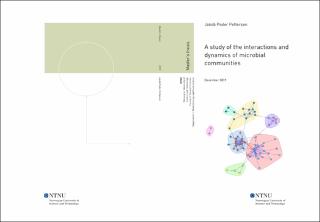| dc.contributor.advisor | Almaas, Eivind | |
| dc.contributor.advisor | Vadstein, Olav | |
| dc.contributor.advisor | Bakke, Ingrid | |
| dc.contributor.author | Pettersen, Jakob Peder | |
| dc.date.accessioned | 2020-06-04T16:00:49Z | |
| dc.date.available | 2020-06-04T16:00:49Z | |
| dc.date.issued | 2019 | |
| dc.identifier.uri | https://hdl.handle.net/11250/2656641 | |
| dc.description.abstract | De seneste årene har strukturen, sammensetningen og interaksjonene i mikrobielle samfunn vært et hett tema i de vitenskapelig miljøene. En rekke næringer som havbruk, vannbehandling og helse har mye å tjene dersom en utvidet forståelse av interaksjoner mellom mikrober kan gjøre oss i stand til å forme de mikrobielle samfunnene til å bli gunstige for våre formål. Studiet av mikrobielle interaksjoner i hele samfunn er et nytt og umodent fagfelt. Derfor finnes i dag ingen vel underbygd og testet teori eller framgangsmåte, noe som fordrer videre forskning på feltet.
For prosjektet ble det brukt OTU-tabeller fra tre forskjellige lab-skala reaktorforsøk, generert ved sekvensering av 16S rDNA. ReBoot, en tversgående algoritme, kombinert med en samling av similaritetsmål, ble brukt for å finner mønstre av sameksistens og gjensidig utelukkelse. I tillegg ble en tidsseriebasert framgangsmåte prøvd ut, der forsøksdata ble tilpasset den generaliserte Lotka-Volterra-likningen, for å se om dynamikken i samfunnene kunne reproduseres.
Interaksjonene som ble funnet gjennom ReBoot, var for det meste positive. Similaritetsmålene klarte å strukturere OTUene som var dominerende under forskjellige seleksjonsregimer selv om resultatene fra ReBoot ikke var noe bedre på dette området enn direkte anvendelse av similaritetsmålene. De predikerte interaksjonsnettverkene viste en struktur med klynger av nært beslektede OTUer med positive interaksjoner mellom seg, og med negative interaksjoner mellom klyngene. Dette funnet var mest sannsynlig en følge av at OTUene i hver klynge hadde samme miljøpreferanser og forekom derfor i de samme prøvene. Av den grunn samsvarte sannsynligvis ikke sameksistensmønsteret overens med den faktiske interaksjonsstrukturen i samfunnene.
Det ble vist at datasettene hadde tidsutviklinger som indikerte deterministisk oppførsel og konvergens mot en stabil tilstand. Dessuten fungerte algoritmen godt til å predikere Lotka-Volterra-koeffisientene til et lite, simulert samfunn. Imidlertid ga modelleringen med Lotka-Volterra ingen fornuftige resultater på dataene fra forsøkene. Blant ga kryss-validering ingen optimal verdi for tilpasningsparametrene, og de predikerte tidsseriene samsvarte ikke med de reelle tidsseriene fra forsøkene. Sannsynligvis skyldtes problemene for lang tid mellom hver prøve, kanskje også at antallet OTUer var for høyt. | |
| dc.description.abstract | The structure, dynamics and interactions of microbial communities have the latest years been a hot topic in the scientific communities. Industries as diverse as aquaculture, water treatment and healthcare would benefit to a major extent if we could utilize a widened understanding of community assembly and interactions to provide a microbial environment fitting our demands. Yet, the field of studying community interactions and dynamics is young and immature. No solid and well-tested theory or approach exist, encouraging further research into this topic.
The data for this project were OTU tables from three different lab-scale reactors experiments, created by 16S rDNA sequencing. ReBoot, a cross-sectional algorithm, combined with an ensemble of similarity measures, was utilized to provide the co-occurrence and co-exclusion patterns of the microbial communities. In addition, a time-series based approach was tired out; the generalized Lotka-Volterra equation was fitted with the experimental data in order to determine whether the dynamics of the communities could be reproduced.
The interactions inferred from the similarity measures through ReBoot were for the most part positive. The similarity measures had the power to distinguish OTUs being dominant under different selection regimes, even though the results from ReBoot were not any better in this respect than the naive application of similarity measures. The predicted interaction networks generally consisted of clusters of closely related OTUs having positive interactions among themselves and negative interactions to the other clusters. The observation was most likely an artifact of the fact that closely related bacteria often have almost the same niche and therefore appear in the same samples. For this reason, the co-occurrence patterns found, most likely did not correspond to causal interactions.
It was shown that the datasets possessed temporal dynamics indicating deterministic behavior and convergence toward a steady state. In addition, the algorithm managed to predict the Lotka-Volterra coefficients accurately on a small artificial test community. However, the Lotka-Volterra modeling gave no reasonable results for the experimental data, as the cross-validation to obtain the tuning parameters provided no optimum and the predicted time series did not resemble the real ones. Too long time spans between sampling points, possibly combined with a too large number of OTUs, is the most plausible reason for the failure. | |
| dc.language | eng | |
| dc.publisher | NTNU | |
| dc.title | A study of the interactions and dynamics of microbial communties | |
| dc.type | Master thesis | |
